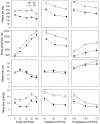Comparison of C57BL/6 and DBA/2 mice in food motivation and satiety
- PMID: 20138902
- PMCID: PMC2840189
- DOI: 10.1016/j.physbeh.2010.02.001
Comparison of C57BL/6 and DBA/2 mice in food motivation and satiety
Abstract
Demand functions describe the relationship between the consumption of a commodity and its mean or unit price. In the first experiment, we analyzed food demand in two strains of mice (C57BL/6 and DBA/2) that differ on several behavioral dimensions, but have not been examined extensively for differences in feeding and meal patterns. Mice worked for food pellets in a continuous access closed economy in which total intake and meal patterns could be measured. A series of fixed (FUP), variable (VUP), and progressive (PUP) unit price schedules were imposed. Under all schedules, DBA/2 mice consumed significantly more food than C57BL/6, a difference that was not attributable to disparity in body weight or weight gain. The higher intake of DBA/2 mice was due predominantly to larger meal size compared with C57BL/6, with no strain difference in meal frequency. In a second experiment, strain differences in meal size were not found to correlate with anorectic sensitivity to cholecystokinin (CCK) administration, or with c-Fos expression induced by CCK in PVN, AP and NTS. Thus, DBA/2 mice were motivated to sustain a higher daily food intake and meal size than C57BL/6 under the range of demand costs employed in the present work, but this strain difference is unlikely to be due to CCK action or responsiveness.
(c) 2010 Elsevier Inc. All rights reserved.
Figures


Similar articles
-
Impaired satiation and increased feeding behaviour in the triple-transgenic Alzheimer's disease mouse model.PLoS One. 2012;7(10):e45179. doi: 10.1371/journal.pone.0045179. Epub 2012 Oct 4. PLoS One. 2012. PMID: 23056194 Free PMC article.
-
Meal patterns of mice under systematically varying approach and unit costs for food in a closed economy.Physiol Behav. 2009 Aug 4;98(1-2):85-93. doi: 10.1016/j.physbeh.2009.04.016. Epub 2009 Apr 23. Physiol Behav. 2009. PMID: 19394352 Free PMC article.
-
Patterns of Brain Activation and Meal Reduction Induced by Abdominal Surgery in Mice and Modulation by Rikkunshito.PLoS One. 2015 Sep 30;10(9):e0139325. doi: 10.1371/journal.pone.0139325. eCollection 2015. PLoS One. 2015. PMID: 26421719 Free PMC article.
-
Cholecystokinin and satiety: current perspectives.Nutrition. 2000 Oct;16(10):858-65. doi: 10.1016/s0899-9007(00)00419-6. Nutrition. 2000. PMID: 11054590 Review.
-
Brain regions where cholecystokinin exerts its effect on satiety.Ann N Y Acad Sci. 1994 Mar 23;713:242-54. doi: 10.1111/j.1749-6632.1994.tb44072.x. Ann N Y Acad Sci. 1994. PMID: 8185166 Review.
Cited by
-
Wistar rats and C57BL/6 mice differ in their motivation to seek social interaction versus food in the Social versus Food Preference Test.Physiol Behav. 2020 Dec 1;227:113162. doi: 10.1016/j.physbeh.2020.113162. Epub 2020 Sep 1. Physiol Behav. 2020. PMID: 32877644 Free PMC article.
-
Ghrelin and eating disorders.Prog Neuropsychopharmacol Biol Psychiatry. 2013 Jan 10;40:70-82. doi: 10.1016/j.pnpbp.2012.08.011. Epub 2012 Aug 30. Prog Neuropsychopharmacol Biol Psychiatry. 2013. PMID: 22960103 Free PMC article. Review.
-
Measuring affect-related cognitive bias: Do mice in opposite affective states react differently to negative and positive stimuli?PLoS One. 2019 Dec 30;14(12):e0226438. doi: 10.1371/journal.pone.0226438. eCollection 2019. PLoS One. 2019. PMID: 31887167 Free PMC article.
-
A one-week 5-choice serial reaction time task to measure impulsivity and attention in adult and adolescent mice.Sci Rep. 2017 Feb 15;7:42519. doi: 10.1038/srep42519. Sci Rep. 2017. PMID: 28198416 Free PMC article.
-
Structure of motivation using food demand in mice.Physiol Behav. 2011 Jul 25;104(1):15-9. doi: 10.1016/j.physbeh.2011.04.042. Epub 2011 May 1. Physiol Behav. 2011. PMID: 21549728 Free PMC article.
References
-
- Vaughan CH, Rowland NE. Meal patterns of lean and leptin-deficient obese mice in a simulated foraging environment. Physiol Behav. 2003;79:275–9. - PubMed
-
- Vaughan CH, Marcus MC, Haskell-Luevano C, Rowland NE. Food motivated behavior of melanocortin-4 receptor knockout mice under a progressive ratio schedule. Peptides. 2006;27:2829–2835. - PubMed
-
- Collier G. A functional analysis of feeding. Advances in the Study of Behavior. 2005;35:63–103.
Publication types
MeSH terms
Substances
Grants and funding
LinkOut - more resources
Full Text Sources

